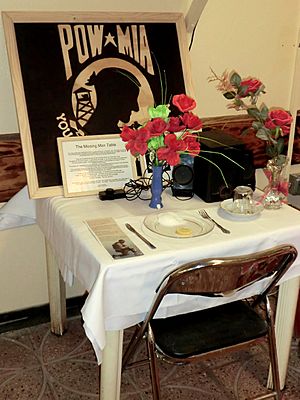Table-setting facts for kids
Table-setting, also called tablescaping, is about decorating dining tables in a creative and artistic way. People do this for special events or for fun competitions.
The word tablescaping is a mix of "table" and "landscaping." It was first used by TV chef Sandra Lee in 2003. In the United States, tablescaping contests happen at county fairs and other events. These competitions have been around since at least the 1930s.
Judges carefully score the tables. Points can be lost if things like glasses, forks, or plates are missing or in the wrong spot. You can earn extra points for being creative or for how well you show a theme. Judges also look at how pretty the table is, if it works well, and how balanced it looks. They might even think about what kind of pretend meal would be served on the table. A table can be set formally or very casually, depending on the theme.
Tablescaping has become more popular because of social media. People often share photos of their meals, including how their tables are set. On Instagram, for example, millions of posts use hashtags like #tabledecor and #tablesetting. A cool trend is to use a rustic or farm theme. This often means using recycled or upcycled materials, which is good for the environment.
Tablescaping can also mean decorating other types of tables. This includes console tables, coffee tables, side tables, or center tables.
A Look Back: The History of Tablescaping
Table-setting became very popular in Western countries in the late 1700s. Rich families, called the aristocracy, used it to show off their style. Since then, themed tables have offered a way to "escape daily life to a fantasy world."
More and more items like silverware, dishes, and glasses were created. This trend reached its peak during the Victorian Era (1837–1901). Back then, a single table setting might have had about twenty expensive items. These items made the table look new and shiny.
Around the mid-1700s, people started using fancy centerpieces. These were a way to show how wealthy they were. They used ornate silver baskets called epergnes, long mirrored trays called plateaus, flowers, and candelabras (candle holders).
In the late 1800s, middle-class families in Europe and America copied the wealthy. But they often used fresh flowers as their centerpieces. In the mid-1900s, women's gardening clubs held displays to promote table decorating.
Images for kids





